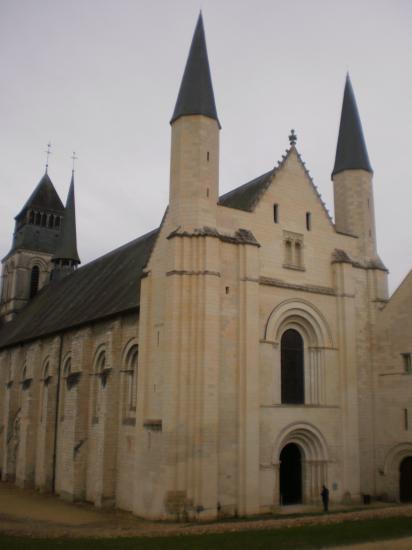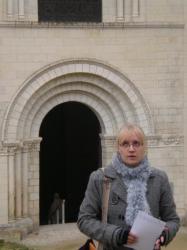Abbaye de Fontevraud (1st)
C'est Ludivine qui débutait la visite de l'Abbaye de Fontevraud. Attention, sa visite était en deux parties (Histoire, et Salle du Chapitre), je les ai séparer par des petits pointillés pour plus de visibilité ! C'est pas trop la classe ??? mdrrr bon ok jm'arrête là ! 
 Welcome to the site of Fontevraud Abbey! During our guided tour Gwendolyn, Marie and I are going to present this place, its architecture, history and functions during the different centuries.
Welcome to the site of Fontevraud Abbey! During our guided tour Gwendolyn, Marie and I are going to present this place, its architecture, history and functions during the different centuries.
First, let’s talk about history. The Fontevraud Abbey was built in 1101. A priest, Robert Of Arbrissel was its founder . He was born in 1045 in Brittany. So, you may wonder why a Briton priest became the initiator of this Abbey. In fact, Robert of Arbrissel was a preacher, in other words, an itinerant priest who travelled from villages to villages. Thanks to these numerous visits, he brought together an important community of worshiping. Indeed, when he arrived in Angers, more than three hundred people were following him. That’s why the community began to look for a place to settle. A friend of Robert called Hersande de Montsoreau gave him the Fontevraud land. At that time, Fontevraud was an arid region without any villages nor cultivated lands, but there was a spring called « fountain of Evrauld » based on the name of a bandit who lived in the nearby forest. So, this fountain gave its name to the village of « Fontevraud ».
In order to keep all the members of his community, Robert decided o found a double religious order: the Fontevrist order which was a mixed order according to the rule of Saint Benedict. It laid down four vows: vows of poverty, silence, obedience and chastity.
Of course, the two orders were separated. The nuns were divided into two monasteries : “Le Grand Moûtier”,which was the bigger and the convent of Madeleine, which received the married women or the widows withdrawing from the world. As for the monks they lived in the convent of Saint-Jean-de-l'Habit which accommodated about fifty monks.
Except the presence of a mixed order, what made this abbey original was its management. Indeed, Robert Of Arbrissel didn’t decide to appoint a man at the head of the order, but a woman called Pétronille de Chemillé who became the first abbess of Fontevraud. I think that her name is completely unknown for you, but you will see later that among the numerous abesses of Fontevraud, we find more famous women like members of the Bourbon royal family.
So, the abbey was led by a woman, which was uncommon at that time. The monks always had to ask the abbess when they wanted something. But why do you think Robert Of Arbrissel let the men be led by a woman ? In fact, he seemed to believe that ,by allowing a woman to be the leader of the order, men deserved even more to go to heaven.
But at the time of the French Revolution, everything changed. The possessions of the clergy became national and were sold or plundered. In the case of Fontevraud, its furniture was mainly sold. Further to this dangerous situation, the monastic community decided to leave the abbey in 1792. The last abbess was Julie D' Antin.
Then in 1804, Napoleon edited a decree which transformed into prison the three biggest monastries of France which were at that time Jumiège, Cluny and Fontevraud. The first prisoners arrived in 1814 and stayed to the closure of the prison in 1963. But some prisoners stayed in Fontevraud to participate in the restoration of the abbey. The last prisoner left Fontevraud in 1985 which is rather recent.
Then, after this part of history, I let Mary present you the abbey church and its architecture!
----------------------------------------
The portal of the Chapter room :
Before visiting the Chapter room, we are going to observe its rather exceptional portal. It was made between 1541 and 1543. It is in full round arch and it is decorated with coats of arms and monograms of the abbesses. Other sculptures are allegorical, mythical or symbolic figures which represent for the greater part the subject of the death, in particular Christ’s death and his passion with its instruments which you can see: studs and lance. On each side of this portal we find two twin windows in boxes girder representing various saints. We also see there an angel chasing away Eve and Adam from Paradize and Saint Veronica presenting her veil. You also see that many statues have the head’s cut, these mutilations are due to the passage of revolutionaries in the abbey.
The Chapter room :
The chapter was an essential room for the religious community where they could meet. Discipline and material issues were treated here in this place. The religious community talked about everyday life and the relationship between the different convents. Novices were admitted and important guests were received . This was also the office of the abbess and the place where she was elected.
A meeting took place every day and before its beginning , the nuns read a chapter of the rule of Saint Benedict. That’s why this room was called « chapter room ».
But this room had another function : on Wednesdays, it was a tribunal where the nuns had to admit their sins face downwards. And if they had committed a sin they were punished by the abbess. According to the sins, the punishment could be more or less hard. If the sins were not very grave, nuns had duties to do, and for the gravest ones they could be locked into a cell, naked in the dark, and with only dry bread and water to live on. Indeed, the Abbey had its own justice, the civil justice was not applied to it.
As regards architecture, we can observe six rib vaults in the Chapter room each one is based on fine columns with Corinthian capitals. You can also see two windows in full round arch which open on both sides of this wall.
Now, let me talk about these paintings which surround us. They represent various scenes of the Christ’s life such as the Passion, the kiss of Judas or also the resurrection. They were painted in 1562 by Thomas Pot, a painter native of Angers. You probably noticed that on these paintings there are a few characters who are not supposed to be here. These are, in fact, the abbesses of Fontevraud . We think that they were added to the original paintings later by other painters after Thomas Pot, let me show you why. On this picture of the kiss of Judas, we can see one foot which appears in the back of the abbess. We believe that the painter deliberately wanted to laugh at her and told her in his own way that she would have deserved a kick in a certain place... Moreover, just like the abbesses, Thomas Pot was honoured in these paintings by representing himself on the picture of the Assumption of the Virgo Marie. He is represented under the features of saint Thomas, the man who stretched out arms to get back the belt of the virgin which an angel give him.
Among the various represented abbesses, maybe some of you have recognized two of the most famous ones : Renée de Bourbon and her niece, Louise de Bourbon who appear on the painting of The Passion of Jesus Christ. Renée is on the right and Louise on the left. They were the first ones to be represented directly on paintings and not after because they had a lot of work done in the abbey. Renée began the renovation , then her niece Louise pursued it and fitted out The Grand Moûtier, three galleries of the convent and the Chapter room.
But these two women did not leave tracks only in paintings, but also in the ground on which you walk. Indeed we can see the coats of arms of Renée de Bourbon and Louise represented by the initials of their names. Maybe these symbols are familiar to you because they are represented more than 600 times in all the abbey. If you don’t believe me, you can always count them to check. These coats of arms didn’t exist in the two abbesses’days but were added in 1866 by Joseph Christaud, a man who was the director of the prison during prison years in Fontevraud. You will learn more about that man with Gwendoline in a few minutes.
Near the coat of arms of Bourbons, you can also see a salamander. It is not an abess’s sign but the emblem of Francis the first. He was a generous donator for the abbey and was also the nephew of Renée de Bourbon. Furthermore, during one of his visits to Fontevraud he was hurt on the head and the monastic community looked after him until he was cured . That’s why we also find the presence of this king in Fontevraud.
Now, may I suggest you to leave this room and follow Gwendolyn who is going to give you more details about the nuns’ everyday life


Commentaires (3)
1. Clem 04/01/2010
Salut Ludivine,
dis mois j'ai pas très bien compris l'histoire des deux ordres et leur répartition dans les monastères. Tu dis que l'ordre et mixed, que les nonnes dorment dans le couvent de Madeleine et que les moines dorment dans le monastère de St jean de l'habit, c'est bien ca? Mais quant est-il des femmes mariées ou veuves devenues nonnes? A quel endroit sont elles?
Merci, Bonne Année
2. marie 04/01/2010
j'avais qq notes là dessus: en gros c'est un ordre mixte pcq il y a à la fois des couvents d'hommes et de femmes. (d'hab, soit l'un, soit l'autre). il y a en tout 4 couvents à fontevraud: 2 pour les hommes, 2 pour les femmes:
Femmes:
-le Grand Moutier (batiments qu'on a visités): "vierges" menant une vie irréprochable
-Couvent de la Madeleine: femmes repenties et veuves
Hommes:
-Prieuré St Lazare: malades et lépreux
-St Jean de l'Habit: hommes en général.
3. Clem 05/01/2010
Merci Marie pour ton explication! Bne année a toi, bne fin de réviz et a bientot!